Tyrant Flycatchers: Photos, Identification, Species, and Behavior
Tyrant flycatchers are the largest bird family in North and South America, with over 400 species spread almost everywhere across these continents. You’ll find them in all sorts of shapes, sizes, and colors – from the tiny, round pygmy tyrants to the eye-catching vermilion flycatcher. Most wear simple, plain feathers, but a few flash bright reds or yellows. Even though telling them apart is tough sometimes, you can spot them by their energetic hunting style and their knack for keeping insect numbers in check.
Table of Contents
ToggleTyrant flycatchers pop up in all kinds of places – from thick rainforests to open grasslands, and even around towns and cities. Their feeding habits change a bit, but a lot of them like to catch insects by zooming out from a perch (birders call this “sallying”). You’ll see the most kinds in the tropics, but familiar types like kingbirds and phoebes show up in lots of habitats across the Americas.
Tyrant Flycatcher Photo Albums by Fawkes Focus
Key Takeaways
- Tyrant flycatchers are the largest bird family in the Americas.
- They come in lots of shapes and behave in different ways.
- You’ll find them everywhere – from forests to city parks.
What Are Tyrant Flycatchers?
Tyrant flycatchers are a big group of birds found mostly in North and South America. They stand out for their size, color, and the way they act. Actually, they make up the largest bird family in the world.
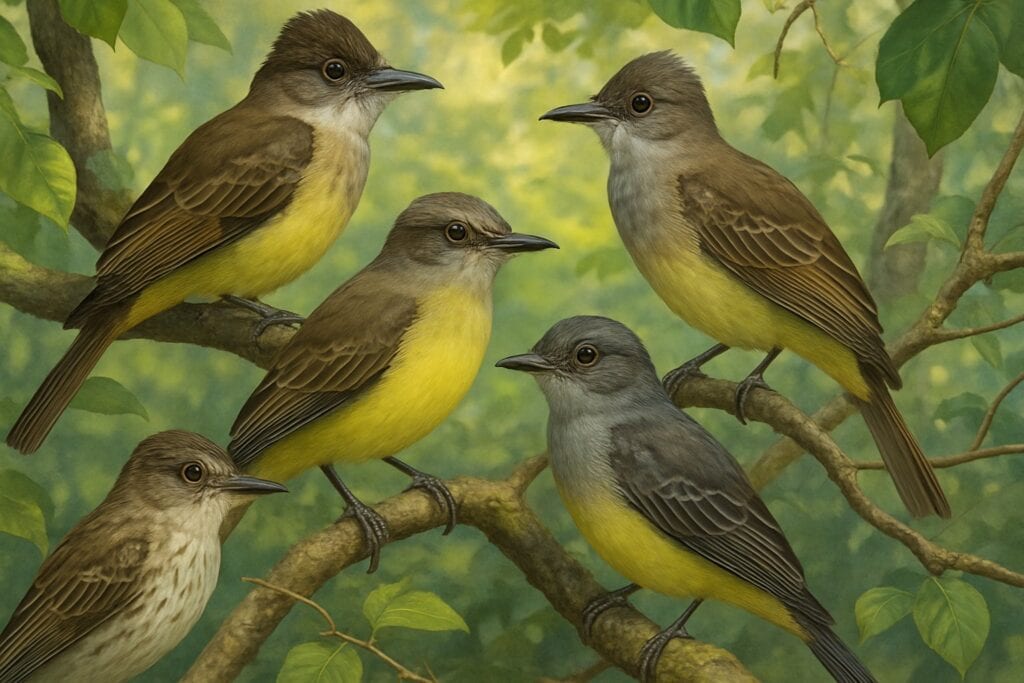
Defining Characteristics
Tyrant flycatchers (family: Tyrannidae) are perching birds that measure anywhere from 7 to 40 centimeters long. Most have plain feathers – gray, brown, olive, or yellow. Still, a few show off with brighter colors.
Most catch insects, darting out from their perch with quick moves called “sallying.” Some eat fruit or even tiny frogs. Their bills are broad at the base and sometimes have little bristles, which help snatch bugs right out of the air.

Behavior? It’s all over the place. A lot of them are loners and guard their space, especially when nesting. This family has some of the tiniest and some of the biggest songbirds out there. Want to know more about how they act? You might like Britannica’s tyrant flycatcher entry.
Taxonomic Classification
Tyrant flycatchers fall under the order Passeriformes (perching birds) and the suborder Tyranni, which bird nerds call suboscines. Unlike the more “musical” birds (oscines), suboscines like Tyrannidae have simpler voice boxes, so their calls are pretty basic.
There are over 400 recognized species in Tyrannidae, spread across more than 100 genera. South and Central America have the most types, but some live as far north as the U.S. and Canada.
Despite the name, tyrant flycatchers aren’t close relatives of Old World flycatchers. Scientists have changed their family tree a bit over time as they’ve studied DNA and behavior. For more, check out Wikipedia’s tyrant flycatcher page.
Subfamilies and Genera
The Tyrannidae family splits up into a few subfamilies, like Elaeniinae, Platyrinchinae, and Tyranninae. Each one has its own twist.
Elaeniinae includes the elaenias, which are small and love chasing insects. Platyrinchinae has flatbills, and Tyranninae features some of the most famous, like kingbirds and great kiskadees.
Some genera, like Empidonax and Myiarchus, are tough to tell apart since they look so much alike. Here’s a quick peek at the variety:
| Subfamily | Example Genera | Notable Species |
|---|---|---|
| Elaeniinae | Elaenia, Myiopagis | Yellow-bellied Elaenia |
| Platyrinchinae | Platyrinchus | Cinnamon Flycatcher |
| Tyranninae | Tyrannus, Pitangus | Eastern Kingbird, Great Kiskadee |
You can read more about tyrant flycatcher groups at this article by Fat Birder.
Distribution and Habitat
Tyrant flycatchers live all over the Americas, from chilly forests to steamy rainforests. They’ve figured out how to survive in everything from grassy plains to thick woods.

North American Range
In North America, you’ll find tyrant flycatchers from southern Canada down through the U.S. and into Mexico. Birds like the Eastern Kingbird and Western Kingbird show up in the U.S. and Canada in the summer, then head south for winter.
Most North American tyrant flycatchers like open spots – think meadows, fields, forest edges, and even parks. A few can handle dry places, but they usually skip deep woods. Some travel huge distances to migrate, while others just stay put in southern spots.
For more about their migration and daily routines, check Encyclopedia.com.
Central and South American Range
Central and South America are tyrant flycatcher central. Here, you’ll find hundreds of species in forests, savannas, mountains, and wetlands. Brazil, Colombia, and Peru are hotspots for these birds.
Most species stick around year-round in the tropics and don’t bother migrating. Rainforests and cloud forests in the Andes are home to both widespread and rare, local species. Some forests in the tropics can have up to 90 different tyrant flycatcher species living together.
If you want to read more about their wild diversity, swing by Wikipedia.
Preferred Environments
Tyrant flycatchers adapt pretty well. You’ll spot them in forests (evergreen or deciduous), savannas, brushy areas, and even cities. Where they live mostly depends on where they can find flying insects.
Some types are picky and only live by rivers, in palm groves, or up on mountain slopes. Others, like the Great Kiskadee, are happy anywhere – even in gardens and towns. That ability to thrive almost anywhere is classic for this family.
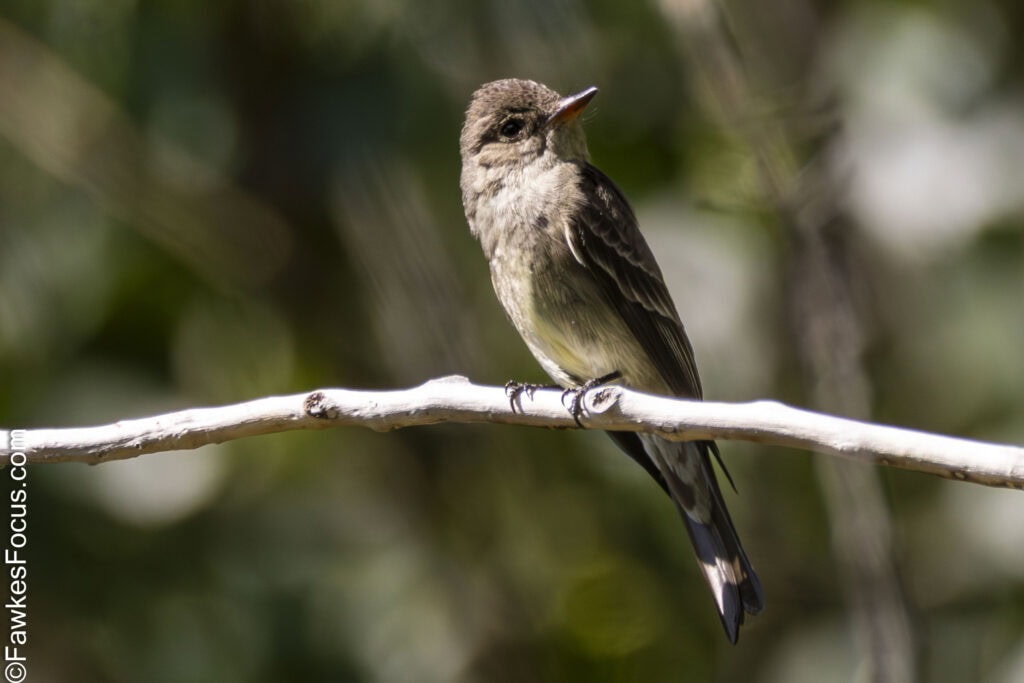
If you’re curious about which birds like which habitats, check out Earth Life.
Physical Characteristics and Identification
Tyrant flycatchers come in all shapes and sizes, and sometimes it’s really hard to tell one from another. Their looks, body size, and even the noises they make can give helpful clues for figuring out who’s who across the Americas.
Size and Coloration
Tyrant flycatchers, part of the Tyrannidae family, range from about 3.5 to 11 inches (9 to 28 cm) long, depending on the species. The Empidonax group is tiny, while kingbirds and scissor-tailed flycatchers are much bigger.
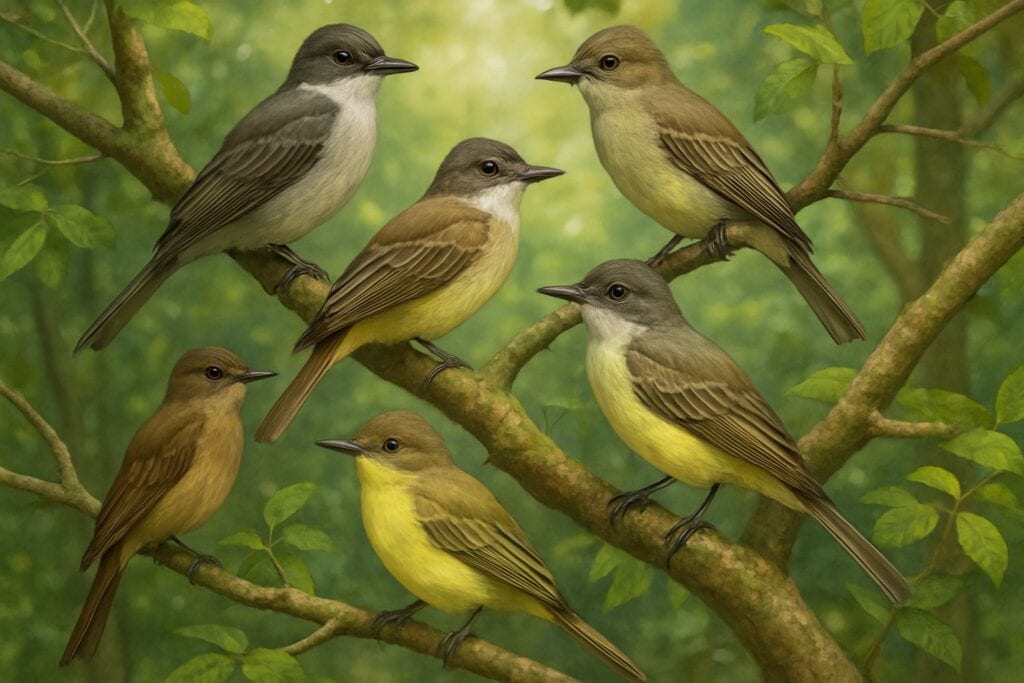
Most wear muted colors – olive-green, brown, gray, or buff. Their bellies are usually lighter, sometimes nearly white. A few, like the vermilion flycatcher, shine bright red, and the great kiskadee stands out with bold patterns. Now and then, you’ll spot flatbills or others with a hint of green or yellow, mostly on their wings or bellies.
Kingbirds usually have pale gray chests with darker wings and tails. A handful of species have colorful crests or spots, but that’s not the norm. With all these subtle differences, ID’ing them can be tricky, especially if you’re just starting out.
Bill Structure
One thing that stands out about tyrant flycatchers is their bill. It’s short and wide, sometimes with a little hook at the end. That shape helps them snap up tiny bugs mid-air.
They’ve got rictal bristles – those stiff, whisker-like feathers – around the base of their bill. These probably help keep bugs from hitting their eyes while they hunt. Most flycatchers have these, but the size and shape of the bill can help you sort out groups like Empidonax, kingbirds, and flatbills.
Flatbills have, well, flatter and wider bills. Empidonax flycatchers go the opposite way – small and plain. Looking close at the beak can really help when you’re trying to tell these birds apart.
Sexual Dimorphism
Male and female tyrant flycatchers usually look almost exactly alike. Not much difference in color or size – unlike some other birds. Both sexes are usually pretty dull, with barely any difference in markings.
There are a couple of exceptions. The vermilion flycatcher, for example, has a bright red male and a much duller female. Some kingbirds and phoebes? Both sexes look pretty much the same.
So, if you’re trying to tell them apart, you’ll need to check out their behavior or listen to their calls instead of just looking at them.
Vocalizations
Tyrant flycatchers rely a lot on their calls to claim territory or find a mate. Each species has its own sound, and honestly, that’s often the best way to tell them apart – especially with those Empidonax flycatchers that all look alike.
Kingbirds and phoebes have sharp, clear calls that stand out. Empidonax species are really tough to tell apart unless you listen for their unique calls.
Getting to know their songs and calls is super helpful, especially in places where lots of species live together. If you’re new to birdwatching, maybe record some calls or listen to examples online – it makes field ID a lot easier (more on tyrant flycatcher diversity and vocalizations).
Major Groups and Notable Species
Tyrant flycatchers make up a huge, varied bird family across the Americas. They fill all sorts of roles in nature, and their behaviors, diets, and looks are just as varied as the places they live.
Elaenias and Tyrannulets
Elaenias and tyrannulets make up some of the tiniest flycatchers around. Elaenias have soft, subtle colors, and honestly, their calls are often the best clue to tell them apart. You’ll find them a lot in woods and along forest edges, especially through Central and South America.
Tyrannulets are just as small and help keep insect numbers down. Some, like the yellow-crowned elaenia and yellow tyrannulet, pop up in lots of places. Others, like the mistletoe tyrannulet or Guatemalan tyrannulet, stick to smaller areas and can be tough to spot in thick leaves.
Common Elaenias and Tyrannulets:
| Common Name | Genus | Example Species |
|---|---|---|
| Yellow-bellied elaenia | Elaenia | Elaenia flavogaster |
| Highland elaenia | Elaenia | Elaenia obscura |
| Yellow-crowned elaenia | Myiopagis | Myiopagis flavivertex |
| Yellow tyrannulet | Capsiempis | Capsiempis flaveola |
Most tyrannulets and elaenias look pretty similar, so you’ve got to watch closely to tell them apart. See more tyrannulet diversity.
Pewees and Phoebes
Pewees and phoebes are mid-sized flycatchers, usually not flashy. Pewees are easy to spot by their upright posture and slim bodies. The Empidonax group, like the willow flycatcher, has a bunch of species that look almost identical. If you want to tell them apart, listening to their songs is usually your best bet.
Phoebes are chunkier, often darker, and have that funny habit of wagging their tails. The eastern phoebe (Sayornis phoebe) is a classic in the eastern U.S. They seem to like being near people – farms, open woods, you name it.
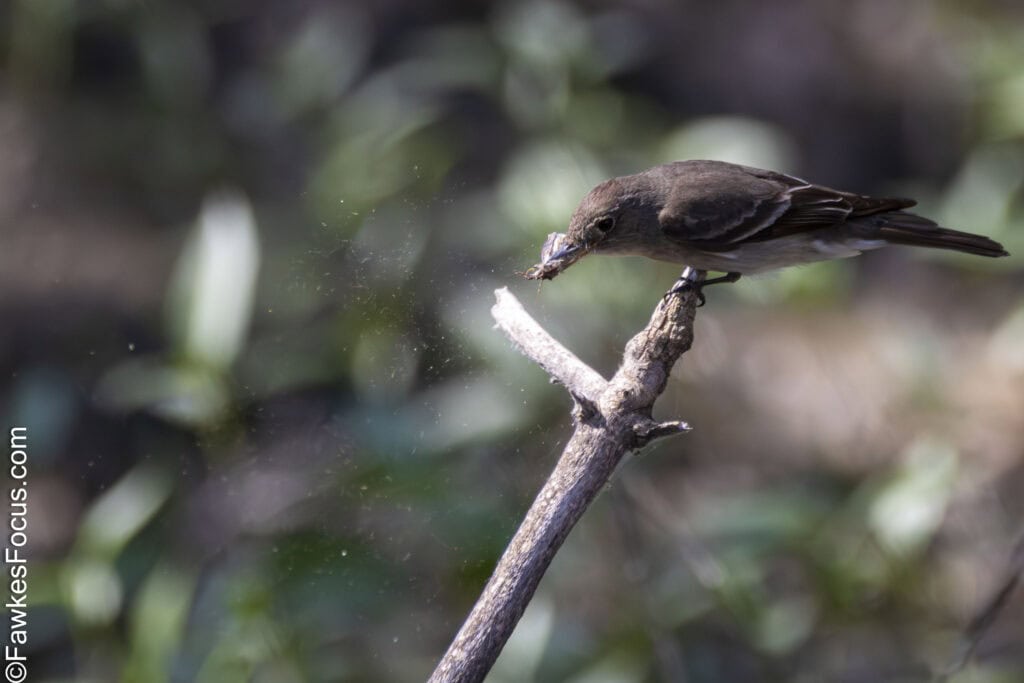
The main Empidonax species:
- Willow flycatcher (Empidonax traillii)
- Least flycatcher (Empidonax minimus)
- Acadian flycatcher (Empidonax virescens)
Phoebes in North America:
- Eastern phoebe (Sayornis phoebe)
- Black phoebe (Sayornis nigricans)
You can find more about these species in the list of tyrant flycatchers.
Kingbirds and Kiskadees
Kingbirds and kiskadees are some of the bigger, bolder flycatchers. Kingbirds (in the Tyrannus group) are gutsy and love open areas. The scissor-tailed flycatcher grabs attention with its crazy long, forked tail. Eastern kingbirds don’t mess around either – they’ll chase off birds way bigger than themselves.
The great kiskadee is super recognizable. It’s got those bright yellow belly feathers, a bold black-and-white head, and a call you can’t ignore. Kiskadees show up in all sorts of places, and with their colors and noisy groups, you really can’t miss them.
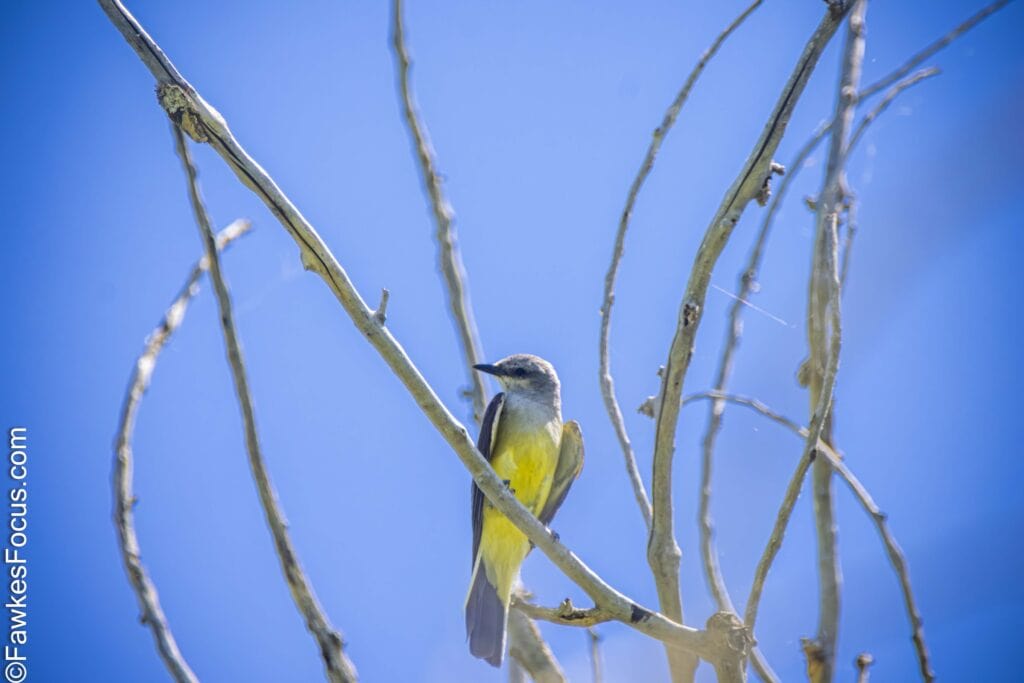
Notable Kingbirds and Kiskadees:
- Great kiskadee (Pitangus sulphuratus)
- Eastern kingbird (Tyrannus tyrannus)
- Tropical kingbird (Tyrannus melancholicus)
- Scissor-tailed flycatcher (Tyrannus forficatus)
You’ll often spot kiskadees and kingbirds sitting out in the open, grabbing bugs mid-air or picking fruit – they eat whatever’s around, really. For more on flycatcher variety, check out the BTO page on tyrant flycatchers.
Other Unique Flycatchers
Some flycatchers just stand out. Black-tyrants (Knipolegus group) wear mostly black or dark feathers. Flatbills and spadebills, like the spadebill (Platyrinchus), have these wide, flat beaks to scoop up bugs.
Tachuris, or “tachuri” flycatchers, are tiny, colorful birds living in South American wetlands. The vermilion flycatcher is a real show-off – the males are bright red with black, so you can’t miss them along rivers or open fields.
Myiarchus flycatchers, like the great crested flycatcher (Myiarchus crinitus), have chunky bodies and like to nest in holes in trees. You’ll find them in forests across both Americas.
A few cool species in this bunch:
- Vermilion flycatcher (Pyrocephalus rubinus)
- Great crested flycatcher (Myiarchus crinitus)
- Black-tyrants (Knipolegus group)
- Flatbills and spadebills (Platyrinchus and others)
You can dig deeper into these and other flycatchers on the Tyrannidae family list.
Behavior and Ecology

Tyrant flycatchers have all sorts of behaviors that help them survive. They eat, nest, and move around in ways that fit their different homes all across the Americas.
Feeding Strategies
Most tyrant flycatchers eat insects. They use a hunting style called “sallying” – they sit and watch, then zip out to grab a bug from the air, ground, or a plant. Different species tweak this style a bit.
Kingbirds, for example, are bold hunters and even chase away bigger birds. While bugs are their main food, a lot of flycatchers also eat fruit, especially when it’s cold and insects are hard to find. Bill shape, wing size, and leg length often match up with how and what they eat.
To avoid fighting over food, different species usually feed in different parts of a forest. Some hunt up in the treetops, others stick to lower branches or near water.
Breeding and Nesting
Most tyrant flycatchers build open, cup-shaped nests in trees or bushes. The female usually does the building and sits on the eggs. Many species are pretty fierce about defending their nesting spots.
Usually, they lay two or three eggs. Both parents feed the chicks once they hatch. Kingbirds are especially known for chasing off much bigger birds that get too close. In cooler places, flycatchers breed when there are lots of insects around to feed their babies.
They don’t like much disturbance near the nest. Some have even figured out how to use buildings or other human stuff for nesting.
Migration Patterns
Migration in tyrant flycatchers really depends on where they live. Birds in the tropics usually stay put all year. But in North America, many flycatchers travel long distances between where they nest and where they spend the winter.
They mostly migrate at night – maybe to dodge predators or stay cool. A few, like the western kingbird and scissor-tailed flycatcher, sometimes move during the day.
Losing the habit of migrating is actually more common than gaining it. This shapes how flycatchers have spread out and changed over time, as seen in big studies of 300+ species. Each species has its own route, timing, and stopover spots.
Conservation and Research
Tyrant flycatchers (Tyrannidae) face some real challenges, even though quite a few species are still common. Ongoing research tracks how they’re doing and what roles they play in their habitats.
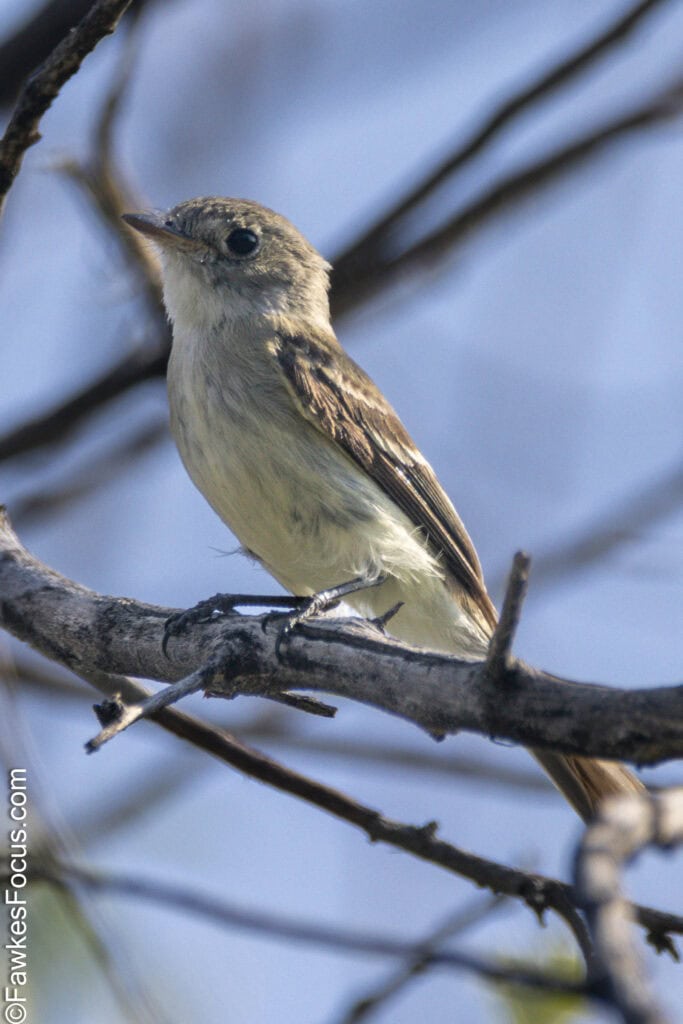
Conservation Status
Some tyrant flycatchers are doing fine, but others are in trouble. In Brazil, the Alagoas tyrannulet and Minas Gerais tyrannulet are both Critically Endangered. They’ve lost most of their habitat and only survive in tiny, scattered groups. Nine other species are Endangered, mostly in South America, and fifteen are Vulnerable – most of those outside North America.
Biggest threats:
- Deforestation
- Chopped-up habitats
- Climate change
- Tiny, spread-out populations
Widespread birds like the great kiskadee aren’t at risk. But for species losing ground, we need real conservation action. There’s a list of at-risk species over at the Encyclopedia.
Current Research and Discoveries
Researchers are busy studying Tyrannidae – tracking migration, foraging, and population shifts. They use tracking gadgets and long-term surveys to follow these birds across continents and see how different landscapes affect their journeys. For example, the cattle tyrant moves between regions each year but also has groups that stay put.
Scientists also look at which flycatchers live where, like in the Cerrado or Amazon, and how that changes with the land. This helps figure out which habitats matter most for rare birds.
They’ve found all sorts of foraging tricks. Some, like the eastern phoebe, hunt from low perches near water or buildings. These studies show how flycatchers handle living around people. There’s more about these movements and foraging styles.
Importance to Ecosystems
Tyrant flycatchers matter a lot in local ecosystems. By eating mostly insects, they help control pests that can damage crops or trees. With so many species, they fill all sorts of roles, from treetops to open fields.
Some bigger flycatchers, like the great kiskadee, even eat fish, frogs, or mice. Their tough defense of nest sites can shape which other birds live nearby. Since they can live in so many places, they’re good signs of how healthy an area is. If flycatchers disappear, it’s usually a warning that something’s off with the environment. For more, see this National Park Service overview.
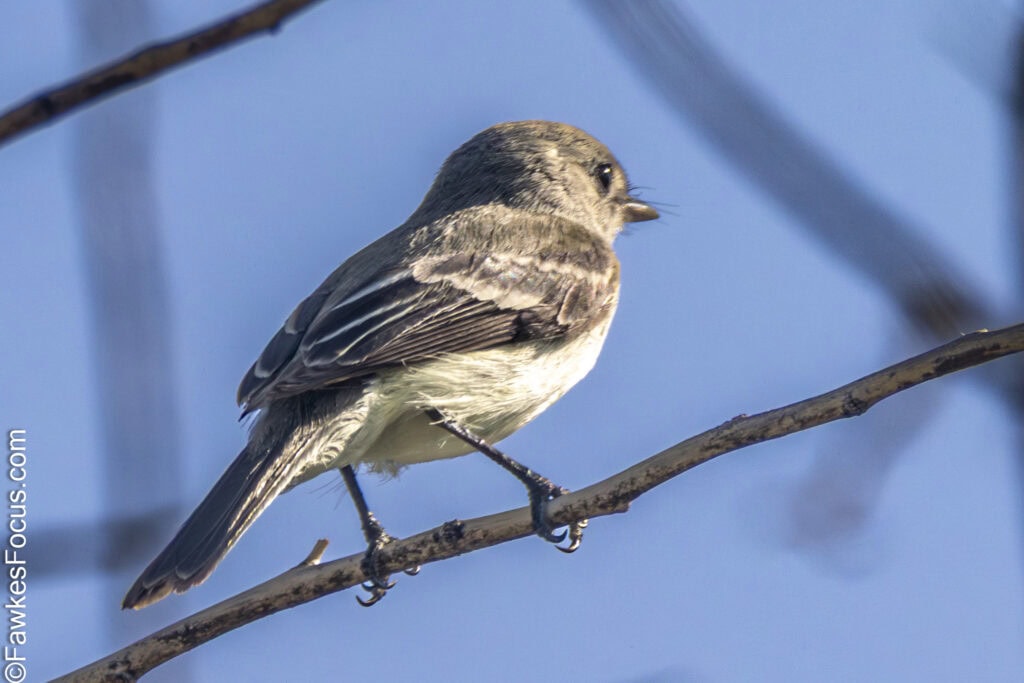
Frequently Asked Questions
Tyrant flycatchers are a huge group – over 400 species! They live all across the Americas, act in all sorts of ways, and are famous for how they catch bugs.
Why are tyrant flycatchers named that way?
They’re called “tyrant” flycatchers because they defend their territories with a lot of energy. Many will even chase off much bigger birds to keep their nests and feeding spots safe.
What is the largest species within the tyrant flycatchers?
The Great Shrike-Tyrant is the biggest of the bunch. It can get up to 29 centimeters long, which is pretty large compared to the others.
Where can one typically find tyrant flycatcher habitats?
You can find tyrant flycatchers in just about any habitat in North and South America – forests, grasslands, wetlands, even cities. Most live in trees, but some like open places or water edges. For more details, check the U.S. National Park Service.
What is the scientific name for the tyrant flycatcher family?
Their scientific family name is Tyrannidae. Every species in this group belongs there, and they’re all part of the passerine (perching bird) order. There’s more at Wikipedia on tyrant flycatchers.
Can you name a genus from the tyrant flycatcher family?
Sure! One famous genus here is Tyrannus. That’s where you’ll find some big, bold flycatchers – like kingbirds, for example.
Which North American bird belongs to the tyrant flycatcher family?
The Eastern Kingbird is a well-known North American bird in the tyrant flycatcher family. You can spot it by its white belly and dark top feathers. It’s kind of bold, too – sometimes it even chases away birds way bigger than itself.